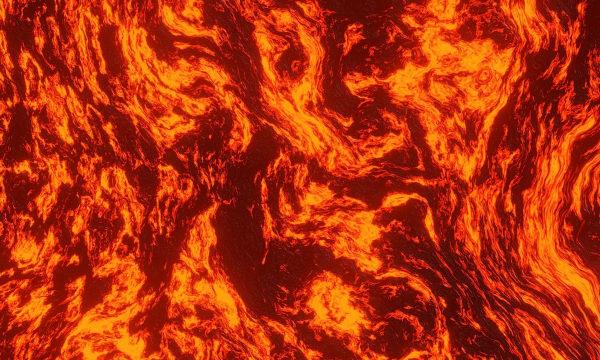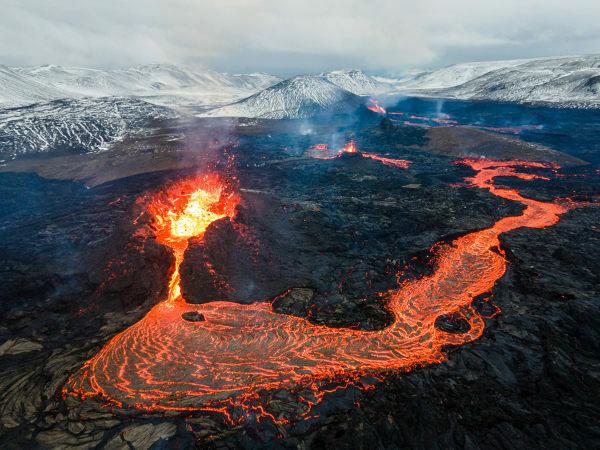Magma is the pasty-textured material that makes up the Earth's mantle, the intermediate layer of our planet located between the lithosphere and the core. Magma also has solid and gaseous parts, being formed from the fusion of rocks in the asthenosphere. Silica and oxygen are the two preponderant elements in the structure of different types of magma, which are classified according to their composition as basaltic, andesitic and rhyolitic. When extravasated to the surface through volcanism, magma becomes called lava.
Read too: Volcanoes — details about the geological structures capable of expelling magmatic material to the Earth's surface
Summary about magma
Magma is the pasty material that constitutes the earth's mantle.
It is formed by molten rocks that begin their melting process in the asthenosphere, part of the upper mantle that lies below the lithosphere.
Pieces of solid rock and dissolved gases are also found in magmas.
Magma is the result of changes in temperature and pressure on rocks.
They are composed of silica and oxygen in greater quantities. Elements such as aluminum, magnesium, calcium and iron can be identified in magma.
The types of magma are: basaltic (more fluid), andesitic and rhyolitic (less fluid).
Lava is magma that was expelled to the Earth's surface through the phenomenon known as volcanism.
Magma is important for the internal balance of planet Earth, for the formation of rocks that make up the lithosphere and for the generation of energy from the heat it emanates.
What is magma?
Magma is the texture material predominantly liquid and also pasty what remains stored inside planet Earth forming the layer known as the mantle, located between the earth's crust (outermost layer) and the nucleus (innermost layer). Magma is essentially made up of molten rocks that have passed through the fusion process due to the high internal heat of our planet or the change in the atmospheric pressure of the environment in which they are located.
Magma has temperatures that vary between 700 and 1,200º C. In certain portions, especially at greater depth, magma temperatures can reach 2,000º C to 3,000º C.
How is magma formed?
The magma forms from the gradual melting of rocks in a solid state, a transformation process that takes place in the upper layer of the mantle called the asthenosphere, located in the transition with the lithosphere.
The change in the physical state of the rocks happens gradually, which is why it can be said that, in certain regions of the mantle, the magma is also composed of a portion of solid material. Dissolved gases are also found in magma, as we will see later.

The melting of rocks and the formation of magma occur due to the marked change in the characteristics of the environment to which this rock is subjected.. These characteristics are temperature and pressure, which vary as the molten rock moves deeper into the Earth's interior. Taking this into consideration, we have that the formation of magma happens by:
temperature increase;
relief of pressure to which the rock was previously, that is, reduction of pressure in relation to the previous environment in which this material was found.
These conditions do not necessarily act in isolation, and the combination of both factors also results in the formation of magma. |1| Furthermore, it is necessary to emphasize that the composition of the rock, that is, the set of minerals of which it is made up, are also determinants for the speed at which the magmatic formation process takes place and for the characterization of other physical properties of magma.
Properties of magma
MagmaIt is a texture material pasty whose degree of viscosity depends on several aspects, such as the composition of the rock that originated this magma, notably the amount of silica in it present, its temperature, the pressure to which it is subjected and the other components found in its interior. Basalt magmas, which have a smaller amount of silica in their composition, are the most fluid, that is, they have lower viscosity. On the other hand, rigolithic magmas are less fluid.
Furthermore, magma is made up of elements found in three physical states of matter: liquid, which corresponds to molten rock; solid, which corresponds to crystallized minerals; and gas bubbles amid the viscous material, formed by water vapor, carbon dioxide, sulfates and methane. |2|
The magma has temperatures very high, especially in those portions that are superimposed on the outer core, in the so-called lower mantle. In this region of the Earth's interior, temperatures can reach 3,700º C. The density of magma also depends on its composition and other physical properties that we have presented so far, which gives this material densities that range between 3.2 and 5 g/cm³.
Also, magma moves in the Earth's mantle through called convection currents. These currents are formed because magma at a higher temperature has a lower density than the material that surrounds it, which causes it to rise to the upper layers of the mantle and head towards the crust terrestrial. The way in which these displacements occur, as well as whether the magma leaks to the surface or remains stored in pockets in the crust, varies according to the composition of the magma.
The magmas present on planet Earth have some elements in common in their composition, such as: silicon (Si) and oxygen (O), which are the two preponderant elements, as well as aluminum (Al), calcium (Ca), magnesium (Mg) and iron (Fe). What varies is the quantity in which they are arranged in the magma, and the way in which they combine to form the different minerals in the molten rock. These different combinations give rise to various types of magma.
Types of magma
Magmas are classified according to their mineralogical composition into:
Basaltic magma: type of magma that has a lower silica content and a lower gas content, which is why it becomes the least acidic, or most basic, of the magmas. Approximately half of its composition is made of silica, with aluminum oxide being the second component that appears in greater quantities. It also has aluminum and iron in its composition, and is formed in regions where plates meet where there is the formation of ridges, already in the Earth's mantle. Along with rhyolitic magma, it is present in greater abundance on Earth. Basaltic magma is the most fluid of the types of magma presented here, and has temperatures above 1,200º C.
Andesitic magma: type of magma intermediate between basaltic magma and rhyolitic magma. It has a silica content of between 50 and 60%, and is formed in subduction zones, in the Earth's crust (both continental and oceanic). Its temperature is between 800 and 1,000º C.
Rhyolitic magma: Also called granitic, it is the most acidic type of magma in existence. It has a high silica content in its composition, which exceeds 60%, and also has a lot of dissolved gas, notably water vapor. The temperature of this type of magma is around 700 or 800º C, and it is the most viscous of the three. Its formation takes place in the contact zone between two continental tectonic plates.
Differences between magma and lava

It is very common for the terms magma and lava to be used synonymously. Even though they are related, however, it is important to know how to differentiate them conceptually. See below the aspects that differentiate magma from lava.
Magma |
Lava |
It is the material in a pasty state that is found inside planet Earth, forming the layer below the lithosphere: the mantle. |
It is the magma that spills onto the Earth's surface and is called lava. The extravasation of magma occurs through volcanic activities (volcanism). |
Importance of magma

Magma is the material that makes up the largest portion of the internal volume of planet Earth. Furthermore, é the main rocks that make up the Earth's lithosphere are formed from it, with rocks classified as igneous (or magmatic). Furthermore, é about the magma that tectonic plates support each other and move. The heat coming from this layer of the Earth is also used for geothermal power generation, which consists of an alternative and sustainable source for the production of electricity.
Volcanism
Volcanism is the natural process of magma leaving the Earth's interior to the Earth's surface. In other words, this phenomenon is nothing more than the leakage of lava from a fracture or any other opening in the Earth's crust that allows magma to pass from the mantle to the surface. Depending on how the process happened, the lava is accompanied by smoke, gases and debris.
Despite the name, volcanism is not associated solely with the eruption of a volcano, but encompasses any lava flow. To find out more details about volcanism, click here.
Grades
|1|It is|2|SZABÓ, Gergely Andres Julio; TEIXEIRA, Wilson; BABINSKI, Marli. Magma and its products. TEIXEIRA, Wilson.; FAIRCHILD, Thomas Rich.; TOLEDO, Maria Cristina Motta de; TAIOLI, Fabio. (Eds.) Deciphering the Earth. São Paulo, SP: Companhia Editora Nacional, 2009, 2nd ed. P. 152-185.
Sources
NATIONAL GEOGRAPHIC. Encyclopedic Entry: Magma. National Geographic, 19 Oct. 2023. Available in: https://education.nationalgeographic.org/resource/magma/.
SZABÓ, Gergely Andres Julio; TEIXEIRA, Wilson; BABINSKI, Marli. Magma and its products. TEIXEIRA, Wilson.; FAIRCHILD, Thomas Rich.; TOLEDO, Maria Cristina Motta de; TAIOLI, Fabio. (Eds.) Deciphering the Earth. São Paulo, SP: Companhia Editora Nacional, 2009, 2nd ed. P. 152-185.
